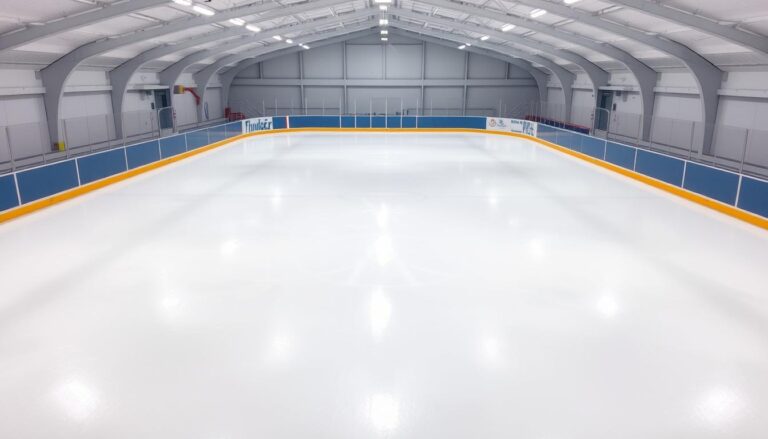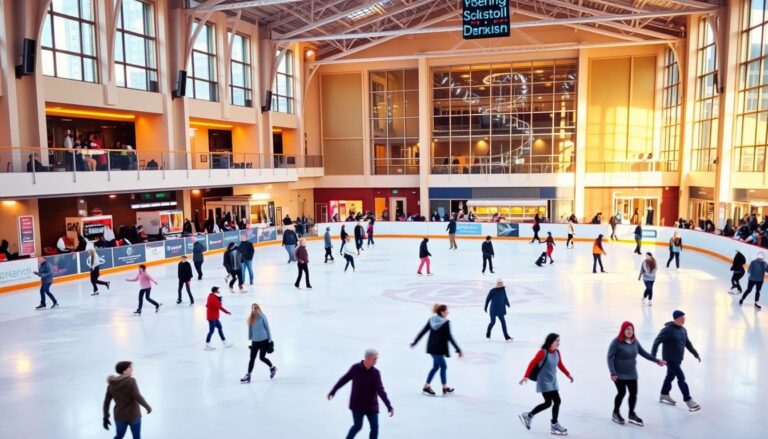Stop Safely on the Ice: Essential Skills for Ice Skaters
Imagine stepping onto the ice for the first time. It’s a mix of excitement and a bit of fear. Learning to stop on ice is key to feeling safe and confident. It turns nervous beginners into skilled skaters.
Stopping might look hard, but it’s a basic skill. It’s what makes skaters go from unsure to sure-footed. Every pro started where you are now, learning to control their speed and balance.
Ice skating is all about balance, technique, and knowing your body. Being able to stop fast and smoothly is vital. It keeps you from falling and lets you enjoy the sport more.
This guide will teach you the essential stopping skills for ice skating. Whether you’re at a local rink or aiming for advanced moves, we’ve got you covered. You’ll learn how to stop smoothly and confidently.
Starting your skating journey means learning to stop well. Each skill takes practice, patience, and a desire to learn. Remember, every pro was once a beginner who kept practicing.
Get set to change how you skate. By the end of this guide, you’ll know how to stop with ease and style. The ice is ready for you. Are you ready to improve your skating?
Understanding the Fundamentals of Ice Skating Safety
Ice skating is thrilling and requires skill and balance. It’s important to learn safety basics first. This helps prevent falls and makes skating more enjoyable.
Safe skating starts with knowing the basics of staying stable on ice. Stopping safely involves technique, the right gear, and being aware of your surroundings.
Basic Balance and Body Position
Your body position is key to safe skating. A good stance helps you stay balanced and in control. Here’s how to stand right:
- Keep knees slightly bent
- Maintain a low center of gravity
- Keep feet shoulder-width apart
- Distribute weight evenly
Essential Safety Equipment
Wearing the right gear is vital for safety. Here are the must-haves:
| Equipment | Purpose | Recommended Type |
|---|---|---|
| Helmet | Head protection | Multi-impact skating helmet |
| Wrist Guards | Prevent wrist injuries | Padded protective guards |
| Knee Pads | Cushion falls | Thick, flexible padding |
Ice Rink Awareness
Knowing your surroundings is key to safe skating. Situational awareness lets you spot dangers and act fast. Always:
- Observe other skaters’ movements
- Know the rink’s layout
- Stay alert to obstacles
- Maintain a safe distance from others
By focusing on these safety basics, you’ll feel more confident and safe on the ice. Safe skating is all about being prepared, using the right techniques, and staying alert.
The Physics Behind Ice Skating Stops
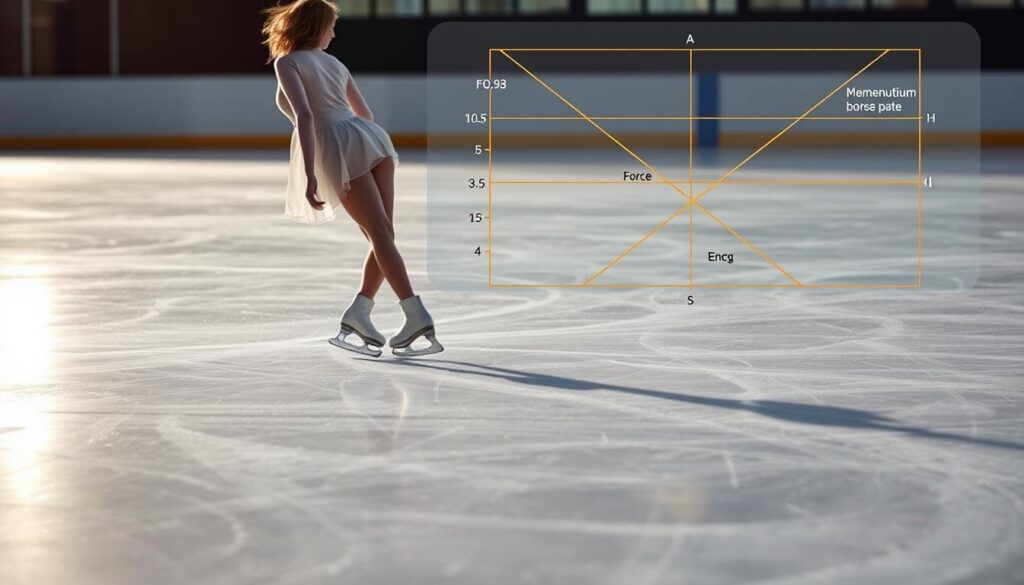
Ice skating braking techniques use basic physics to stop smoothly. Knowing the science behind these movements can make you skate better and safer.
Several key physical forces are at work when you stop on ice. These include:
- Friction: The interaction between your skate blade and the ice surface
- Momentum: Your body’s speed and direction of movement
- Weight distribution: How you position your body to create resistance
Stopping on ice is a science. Your skate blade creates a thin layer of water on the ice, lowering friction. Skaters use this to stop precisely.
Different stopping methods use physics in different ways:
- Snow plow stops generate side friction
- Hockey stops create sudden directional change
- T-stops leverage blade angle to slow momentum
Professional skaters know stopping isn’t just about muscle memory. It’s about understanding how physics works together for safe stops.
How to Stop When Ice Skating: A Complete Guide
Learning to stop on ice is key for safety and confidence. It’s important for both beginners and those looking to improve. Knowing how to stop right can make your ice skating better.
Stopping on ice needs precision, balance, and practice. The right way can stop you smoothly or prevent a fall.
Proper Stance for Stopping
Your stopping stance is the base of good braking. Skaters should:
- Keep knees slightly bent
- Maintain a low center of gravity
- Position feet shoulder-width apart
- Keep arms relaxed but ready to balance
Weight Distribution Techniques
Right weight distribution is vital for smooth stops. Lean slightly forward and spread your weight evenly on both skates. This keeps you in control and prevents slipping.
Common Stopping Mistakes to Avoid
Many skaters face issues with stopping. Here are common mistakes:
- Keeping legs too stiff
- Panicking and tensing up
- Looking down instead of ahead
- Attempting to stop with locked knees
Practice is key to mastering ice skating stops. Start slow, work on your technique, and build confidence in stopping.
Mastering the Snow Plow Stop
The Snow Plow Stop is a key skill for beginners in ice skating. It helps you slow down or stop safely on the ice. This makes it a must-know for new skaters.
Learning to stop with the Snow Plow Stop is a great way to start. It teaches you how to brake gently. By making a wedge shape with your skates, you slow down and stay balanced.
- Proper foot positioning is key for a good Snow Plow Stop
- Where you put your weight affects how well you stop
- The angle of your skates also changes how fast you stop
To do a Snow Plow Stop right, follow these steps:
- Begin in a relaxed skating stance
- Slowly push your heels outward
- Bend your knees a bit
- Press down on the inside edges of your skates
- Keep your upper body steady
Practice is the key to getting better at stopping on ice. Start slow and get faster as you feel more confident. Practice on a flat area of the ice to get better.
Remember, safety is always first when learning new skating moves. Always wear protective gear. Also, taking lessons from a pro can help you improve your Snow Plow Stop.
T-Stop Technique: Step-by-Step Instructions
Learning to stop on ice skates takes skill and practice. The T-Stop is a key technique that boosts your skating skills. It helps you slow down smoothly, making it essential for all skaters.
Ice skating drills are vital for mastering the T-Stop. Before diving into the T-Stop, you need to know the basics of skating.
Preparation Phase
Before starting the T-Stop, it’s important to know how to position your body. Here’s how to get ready:
- Wear protective gear like a helmet and wrist guards
- Stand low and athletic
- Keep your knees slightly bent
- Make sure your weight is evenly distributed
Execution Steps
The T-Stop needs precise movements and balance. Follow these steps:
- Start gliding on your dominant foot
- Turn your trailing foot at a right angle to your path
- Drag the foot behind you to create friction
- Slow down gently
Practice Drills
Getting good at the T-Stop takes practice. Try these drills to improve:
- Slow-speed drill: Practice at slow speeds to build confidence
- Balance challenge: Hold the T-Stop for longer periods
- Controlled stopping: Stop smoothly while increasing your speed
Consistency is key in mastering the T-Stop. Regular practice will make it second nature.
Hockey Stop: Advanced Braking Method
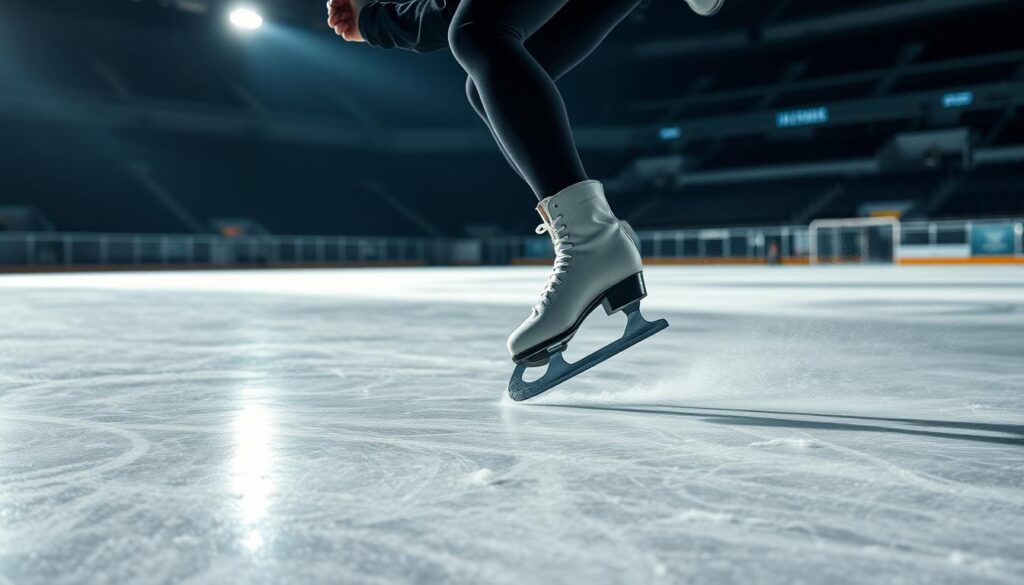
Mastering ice skating stops is all about precision and skill. The hockey stop is the most impressive braking technique. It turns ordinary skaters into confident athletes who can stop quickly and dramatically.
The hockey stop is a powerful technique that sets apart novice skaters from experienced ones. Skaters use a sideways sliding motion. This motion creates a dramatic spray of ice and stops them immediately.
- Requires exceptional edge control
- Demands precise weight distribution
- Develops core strength and balance
To execute a perfect hockey stop, skaters must:
- Approach with moderate speed
- Rotate body perpendicular to original direction
- Shift weight onto outside edges
- Dig edges into ice while maintaining balanced stance
Professional skaters practice this technique extensively to develop muscle memory and confidence. The key to mastering ice skating stops is consistent practice and understanding the biomechanics of edge control.
Beginners should start with protective gear and practice on smooth, less crowded sections of the ice. Gradual progression helps build the skills needed for a smooth and controlled hockey stop.
Progressive Stopping Techniques for Beginners
Learning to stop on ice is key for beginners. It turns them from nervous to confident skaters. Stopping skills grow with patience and practice. Every skater starts with basic techniques that are the foundation for more.
Stopping techniques get better in steps. This helps skaters feel more confident and in control. Beginners go through stages designed to help them improve.
Starting with Basic Stops
New skaters should start with these basic stops:
- Snow plow stop (most beginner-friendly technique)
- Heel brake method
- Gentle gliding slowdown
Building Confidence
Building stopping skills needs both mental and physical practice. Skaters should:
- Practice in a safe, controlled environment
- Start with slow movements
- Use protective gear
- Take lessons from professional instructors
Progression Timeline
A typical learning path for stopping on ice is:
- Week 1-2: Basic snow plow stop
- Week 3-4: Controlled gliding and speed management
- Week 5-6: Introduction to more advanced stopping techniques
Remember, everyone learns at their own pace. Stay patient, keep practicing, and celebrate every small step in your skating journey.
Emergency Stopping Procedures on Ice
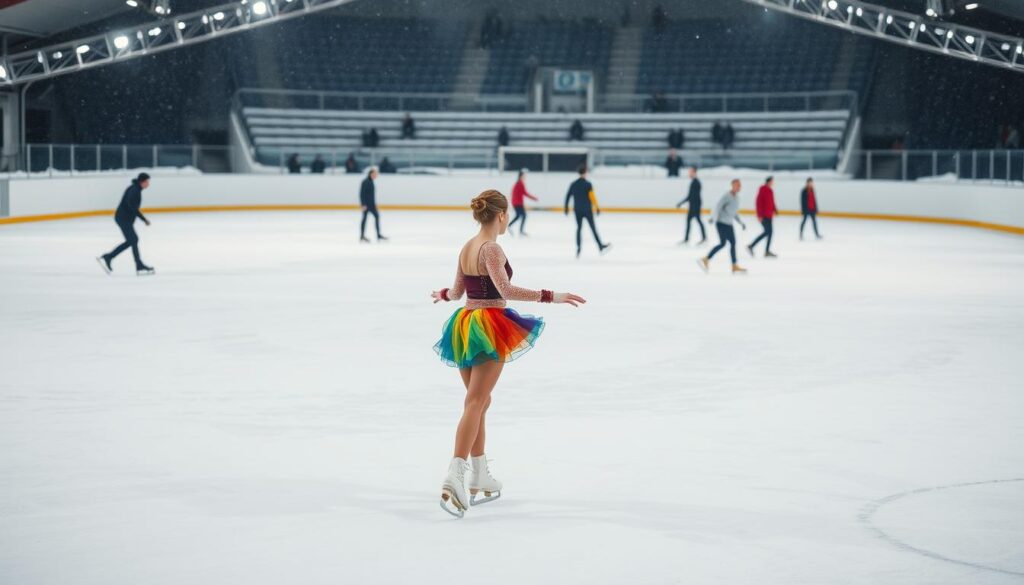
Skating can be full of surprises, and knowing how to stop safely is key. Learning emergency stopping techniques helps you stay safe and avoid injuries.
When stopping on ice, your main goal is to stay in control. Skaters need to react fast to obstacles or losing balance. This keeps you safe.
- Assess your surroundings quickly
- Choose the most appropriate emergency stop method
- Maintain a low center of gravity
- Keep your body relaxed but alert
The “fall small” technique is vital when stopping isn’t an option. It involves:
- Tucking your chin to protect your head
- Keeping arms close to your body
- Rolling slightly to distribute impact
- Avoiding rigid, straight-leg landings
Pro tip: Practice emergency stopping techniques in a controlled environment before attempting them at higher speeds or in crowded rinks.
Advanced skaters say practicing often helps. Knowing various stopping methods boosts your confidence. It also lowers the chance of serious injuries in unexpected situations.
Common Mistakes to Avoid While Stopping
Learning to stop well in ice skating is key. It keeps you safe and helps you skate better. Even pros can find stopping tricky.
Good stopping in ice skating means paying attention to a few areas. Skaters often make mistakes here:
Balance Challenges
Staying balanced is vital when stopping. Many skaters struggle with this, leading to falls or bad braking.
- Leaning too far forward or backward
- Incorrect weight distribution
- Rigid body posture instead of flexible positioning
Speed Control Difficulties
Controlling your speed is key for safe stops. Many skaters find it hard, which can be risky.
- Underestimating stopping distance
- Panicking during high-speed approaches
- Failing to anticipate ice conditions
Positioning Errors
Precise body alignment is important for good stops. Skaters often make small mistakes that affect their stopping.
- Misaligned feet during snow plow stops
- Incorrect ankle and knee angles
- Inconsistent edge control
By knowing and fixing these common errors, you’ll stop better and feel more confident on the ice.
Building Confidence Through Practice Drills
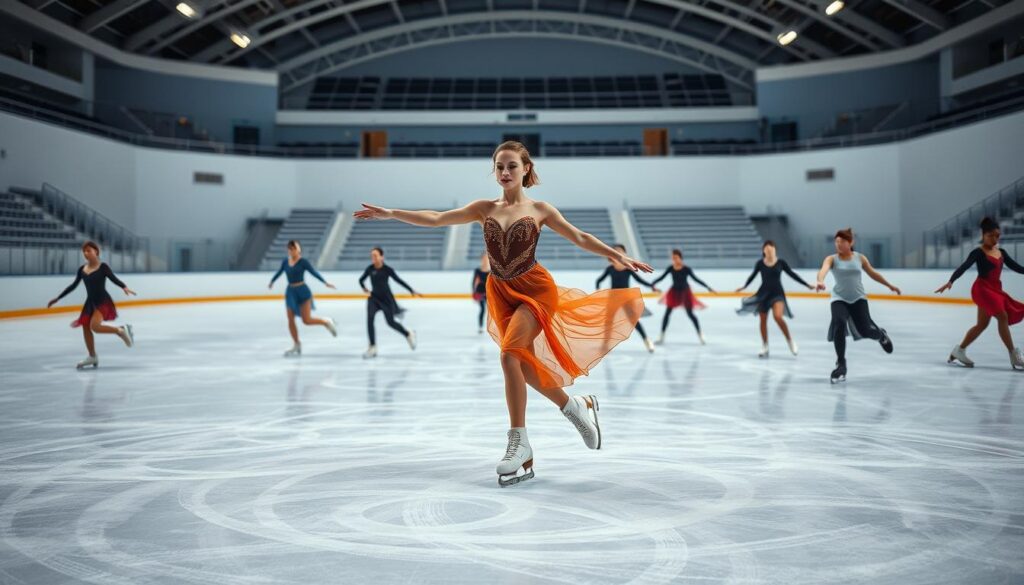
Mastering ice skating stops needs a lot of practice and learning new skills. Feeling confident on the ice comes from knowing the right techniques and practicing stopping. These drills will change how you skate and help you control your movements better.
Good practice starts with drills that focus on stopping. Skaters must work on balance, edge control, and how to distribute their weight. This helps develop reliable stopping skills.
- Start with stationary stop practice
- Gradually increase movement speed
- Use visual markers for precision
- Practice different stopping methods
Ice skating stop drills should be done in a planned way. Beginners can start with the snow plow stop, which is stable and easy to control. More advanced skaters can try harder techniques like the hockey stop.
Key elements for mastering ice skating stops include:
- Maintaining proper body alignment
- Developing edge control
- Understanding weight transfer
- Building muscle memory
Pro tip: Practice drills consistently and gradually increase difficulty to build true confidence on the ice.
Remember, getting better takes time. Every practice session brings you closer to being a better and more confident skater. The most important thing is patience, repetition, and a desire to learn from each try.
Advanced Stopping Techniques for Experienced Skaters
Experienced ice skaters know that mastering advanced ice skating braking techniques goes beyond basic stops. These controlled stops in ice skating require precision, body awareness, and years of practice to execute flawlessly.
Professional skaters develop unique stopping methods that combine technical skill with artistic expression. These advanced techniques transform stopping from a safety mechanism into an elegant movement that showcases skating expertise.
- Power Slide Stop: A dramatic technique where skaters create a controlled sideways glide
- Backward Edge Stop: Utilizing back inside and outside edges for precise deceleration
- Figure Skating Inspired Stops: Incorporating dance-like movements into braking
Each advanced stopping technique demands rigorous practice and perfect body alignment. Skaters must develop exceptional core strength, balance, and muscle memory to execute these sophisticated moves.
Key elements of advanced ice skating braking techniques include:
- Precise weight distribution
- Edge control
- Ankle flexibility
- Smooth momentum reduction
Professional skating coaches recommend dedicating specific training sessions to refining these controlled stops in ice skating. By breaking down complex movements into smaller components, skaters can gradually build confidence and skill.
Remember, advanced stopping techniques are not just about looking impressive—they represent a critical skill set for safety and performance on the ice.
Safety Tips for Stopping at Different Speeds
Learning to stop safely on ice is key. It matters how fast you’re going. Whether you’re new or experienced, knowing how to stop is vital. It keeps you from falling and makes skating safer.
Stopping on ice is tricky. It depends on your speed and where you are. Stopping safely isn’t just about how you do it. It’s also about knowing your surroundings and controlling your body.
Low-Speed Stopping Strategies
At slower speeds, you can stop more easily. Here’s how:
- Slowly move your weight to make friction
- Use the inside edge of your blade
- Stay balanced and centered
- Keep your knees slightly bent for stability
High-Speed Emergency Stops
Emergency stops need quick thinking and skill. You should:
- Stand wide and stable
- Turn your blades sideways fast
- Press down hard to stop
- Keep your core tight and balanced
Group Skating Safety Considerations
Skating with others requires extra care. Always communicate your plans. Keep a safe distance and practice stopping together. This helps avoid accidents and keeps everyone safe.
Practice is essential. Regular training helps you become more confident in stopping. It’s important to know your limits and practice at different speeds.
Conclusion
Learning to stop on ice is more than a skill—it’s about feeling confident and in control. The techniques you’ve learned turn uncertain glides into smooth, precise stops. This keeps you safe and in charge.
Getting better at stopping takes time and practice. With each session, you build muscle memory. This helps you go from being a little unsure to a confident skater who can stop smoothly.
Don’t think your journey ends here. Keep practicing, stay patient, and be ready to try new things. These skills are key, whether you skate for fun or to compete.
We encourage you to get out there and practice. Share your progress and celebrate your wins. Keep exploring the exciting world of ice skating. Your stopping skills are your key to freedom on the ice!


